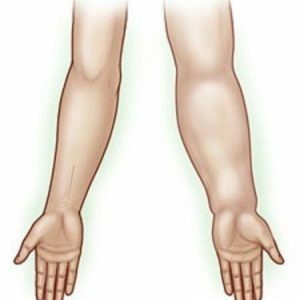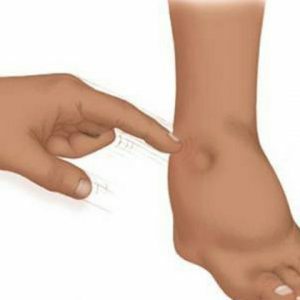Lymphostasis of lower and upper extremities: signs and treatment

Lymphostasis is a pathology caused by impaired lymph flow and lymph circulation in the body's tissue structures.The disease develops against the backdrop of stagnation of lymph. This disease is called in the people "elephantiasis" and, as a rule, affects the area of the patient's legs or hands.
Table of contents: Characteristics of pathology What does it occur from?Manifestations of pathology What is the danger of lymphostasis?How is the diagnosis made?Treatment of lymphostasisCharacteristics of the pathology
Lymphostasis is a pathology of the lymphatic system.With the development of this disease thickens the skin of the patient, there is swelling.As the pathological process progresses, the diseased limbs become noticeably thicker, and ulcerative lesions appear on them.
Note: according to static data, in the world about 10% of people suffer from lymphostasis!
According to the international classification, doctors distinguish two types of lymphostasis :
- Primary - is caused by lymphatic insufficiency, lymphatic pathology, which is congenital in nature. In most cases, signs of primary lymphostasis appear in the patient already in childhood or adolescence.
- Secondary - develops against the backdrop of traumatic injuries and patient-borne diseases that adversely affected the condition of the lymphatic system. As a rule, the pathological process affects only one limb and is manifested in adulthood .
Important ! The pathological process with lymphostasis develops gradually and passes several successive stages.
Which stages of lymphostasis are secreted?
-
 in the first stage shows a mild minor swelling, which is of an incoming character;
in the first stage shows a mild minor swelling, which is of an incoming character; - for the second stage is inherent in the manifestation of persistent, permanent edema of irreversible direction;
- in the last, the third stage, manifestations of lymphostasis complications of fibrosis, trophic ulcer lesions, a significant increase in the affected limb, called the people "elephantiasis".
Where does it come from?
The causes of the development of lymphostasis largely depend on the form of the disease.Thus, primary lymphostasis is congenital in nature, its manifestations are caused by genetic disorders and pathologies of the lymphatic system .
The development of secondary lymphostasis can, in the opinion of physicians, provoke the following factors of :
- traumatic injuries of the lymphatic system( resulting from patient's dislocations, fractures, surgical interventions in the upper or lower extremities);
- lymph node damage and cardiovascular failure;
- renal pathology and renal dysfunction;
- inflammatory processes affecting the skin of the limbs, face;
- tumor neoplasm of benign or malignant, located in the region of the lymphatic system;Venous chronic insufficiency
- ;
- overweight, obesity;
- infectious parasitic diseases;
- protein deficiency;
- surgical removal of lymph nodes;
- patient's surgical operations in the thorax;
- paralysis;
- continued adherence to bed rest;
- thromboses;
- processes of an oncological nature, affecting the sternum or directly lymphatic system.
Important ! According to statistical data, 80% of the fair sex representatives who underwent surgery for the removal of the breast showed a complication in the form of a secondary type of lymphostasis!
Regardless of the causes of lymphostasis, this disease must be treated, as the permanent accumulation of lymph and the disorder of the lyophilization processes invariably leads to the development of extremely undesirable complications!
Manifestations of pathology
The first, the main manifestation of lymphostasis, which is noticeable already at the initial stages of the pathological process is swelling. In most clinical cases, swelling occurs in the evening hours, after physical exertion, etc.
In addition, doctors identify the following clinical signs associated with a disease such as lymphostasis:
- pain;Joint pain;
- manifestations of inflammatory nature;
- increase in size and thickening of the limb, the appearance of painful cracks and ulcerative lesions on the skin;
- formation of fibro-dermis, the appearance of vascular spots, hyperpigmentation of the skin, eczema;
- excessive drying of skin;
- convulsive syndrome;
- excessive sensitivity of the affected limb;
- proliferation of connective tissue structures;
- increase in body weight;
- headaches;
- general asthenia, weakness, increased fatigue, decreased ability to concentrate;
- appearance in the language of a specific white coating.
Note: in the late stages of lymphostasis in the skin, as well as subcutaneous tissue, causes abnormal irreversible changes that disrupt the mobility and motor activity of the joint tissues of the affected limb!
It is recommended to seek help from a specialist at the initial stages of the development of the process, when lymphostasis is manifested by a slight puffiness and weak, periodic painful sensations! The general medical forecast is considered the most favorable, if to begin therapeutic actions just at this time!
What is the danger of lymphostasis?
 This disease, like lymphostasis, is accompanied by severe pain, serious impairment of the lymphatic system, which adversely affects the condition of the whole organism. This ailment gives the patient a lot of discomfort and anguish, disrupts motor activity and can cause disability.
This disease, like lymphostasis, is accompanied by severe pain, serious impairment of the lymphatic system, which adversely affects the condition of the whole organism. This ailment gives the patient a lot of discomfort and anguish, disrupts motor activity and can cause disability.
Do not forget that lymphostasis literally disfigures the appearance of the patient, which leads to severe psychological trauma!
In addition, lymphostasis can trigger the development of the following complications:
- affection of nearby tissue structures;
- trophic ulcers, extremely difficult to treat;
- sepsis;
- lymphosarcoma - formed with prolonged course of the disease.
In order to avoid such adverse consequences, it is necessary to apply to a specialist in due time, undergo complex diagnostics and a full therapeutic course!
How is the diagnosis made?
Diagnosis of lymphostasis requires a complete, comprehensive examination of the patient, aimed at identifying possible causes of pathology.
Patients with suspected lymphostasis are assigned the following types of diagnostic tests:
-
 general and biochemical blood test;
general and biochemical blood test; - lymphographic examination;
- ultrasound examination;
- chest X-ray;
- lymphoscintigraphy;
- computed tomography;
- magnetic resonance imaging.
Based on the results of the performed diagnostics, the expert puts an accurate diagnosis and appoints the patient the optimal and most effective therapeutic course for him.
Treatment of lymphostasis
Conservative therapy
Therapy for lymphostasis should be aimed at normalizing lymphatic drainage processes, eliminating stagnant phenomena, preventing the development of concomitant complications and further progression of the pathological process.
An unchanged way to fight against lymphostasis is massage, which helps to normalize lymphatic circulation processes.A good therapeutic effect is provided by elements of water massage.
In addition, patients are prescribed the following physiotherapeutic procedures:
-
 magnetic therapy;
magnetic therapy; - holding of hardware pneumocompression;
- laser therapy;
- exercise physical therapy;
- phonophoresis;
- electrophoresis;
- irradiation of the affected limb with ultraviolet rays;
- electrical stimulation.
Drug treatment for lymphostasis, as a rule, has an auxiliary, symptomatic direction.
In most cases, patients are prescribed the following medications:
- immunomodulating agents;
- drugs that increase vascular tone;
- angioprotectors;
- diuretic medication;
- glucocorticoids.
All medicines must be assigned to the patient by his attending physician individually, taking into account the stage of the disease and its clinical manifestations!
Note: the average duration of the therapeutic course for lymphostasis is about a month.Treatment, as a rule, is conducted in conditions of hospitalization of the patient.
Diet therapy
In the course of the treatment course aimed at combating lymphostasis, patients are required to prescribe a special diet based on limited consumption of salt.
Specialists strongly recommend the patient to minimize the presence in his daily diet of salt and salty products that promote the accumulation of fluid in the tissue structures.Water should also be taken with a moderate .
In addition, it is better to exclude the following products from the menu:
- sugar;
- potatoes;
- bakery products;
- rice;
- pasta.
Food for lymphostasis should be especially rich in vitamins and nutrients that reduce the viscosity of lymph.
Therefore, the daily diet of a patient suffering from this disease must include the following products:
- fruit;
- fresh vegetables;
- sour-milk products;
- grenades and pomegranate juice;
- cranberry;
- currant;
- grapes.
Important !Patients with lymphostasis need to monitor their weight.To eat it is necessary in fractional, small portions, preferring steam, boiled and stewed food!
Surgical methods for the treatment of lymphostasis
 Surgical intervention, in most cases, is used for advanced forms of lymphostasis, late stages of the pathological process, and in the absence of the effectiveness of conservative methods.
Surgical intervention, in most cases, is used for advanced forms of lymphostasis, late stages of the pathological process, and in the absence of the effectiveness of conservative methods.
In the process of surgery, the surgeon creates additional, artificial pathways in the affected limbs for lymphatic circulation.This procedure gives good results, leads to an improvement in the patients' condition and prevents the development of possible complications.
Also in the treatment of lymphostasis, modern surgeons use the following techniques:
- liposuction;
- dermatofasciolipectomy surgery;
- microsurgery aimed at creating areas of a lymphovenous connection.
In the case of the primary form of lymphostasis, an operation is needed to transplant the patient to a healthy donor tissue lymphocomplex.
The recovery period after surgery for lymphostasis is about 2 weeks.
How to prevent pathology?
To prevent the development of lymphostasis and to minimize the risks of possible relapse, doctors advise patients:
- refrain from excessive physical exertion and avoid lifting heavy weights.
- wear comfortable, comfortable and appropriate shoes;
- regularly undergo preventive medical examinations, monitor the functioning of the kidneys, cardiovascular and lymphatic systems;
- visit the sanatorium, undergo physiotherapy aimed at strengthening the lymphatic system;
- to lead a lively lifestyle, engage in swimming and other sports;
- is right, balanced to eat.
Complex, competent treatment of lymphostasis allows to achieve stable remission, significantly improve the patient's condition and improve the quality of his life.However, this pathology does not lend itself to complete cure, so the patient must regularly visit a specialist, follow a diet and undergo therapeutic preventive courses!
Elena Sovinskaya, medical reviewer



